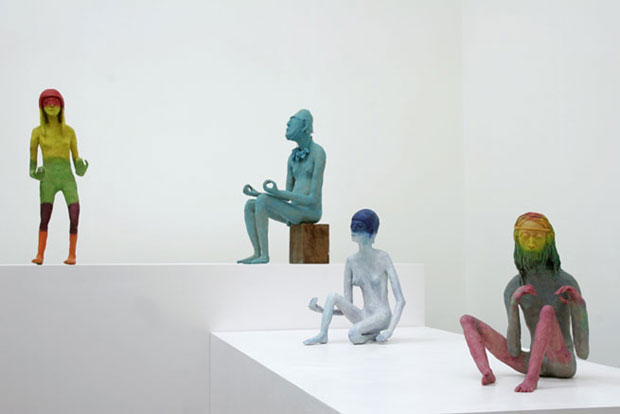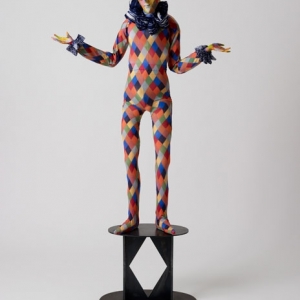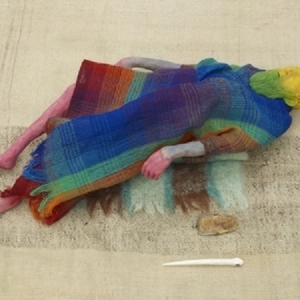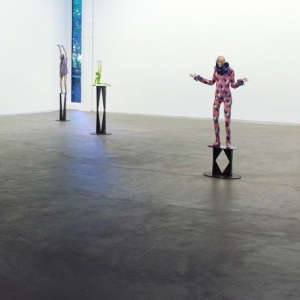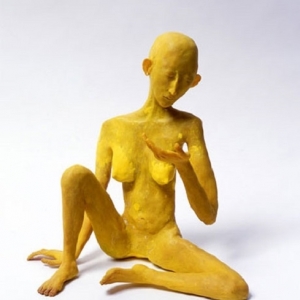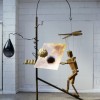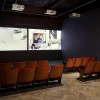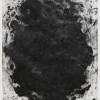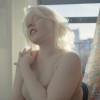For the writer of the exhibition guide,the gothic tales of Mervyn Peake, and the motley group of misfits from Ingmar Bergman’s The Seventh Seal, spring to mind. And the sculptures are certainly rich in association, although the most potent of Upritchard sculptures tend to have the mind springing less to the denizens of other art forms, than concentrating it exclusively on this exhibition.
Liar is perhaps the prime example. Like some of the other figures, which seem to share the same clay genes, she stands with slit eyes and a mouth like the slot of a church poor box, her breasts exposed, a shapeless brown dress hanging from her flattened tube of a waist. The patches of light green paint that mottle her face and body, like fluorescent eczema, hint of decay; but if she’s a creeping corpse she’s intent on taking the profits of her lying tongue to whatever afterlife will have her, for there’s a little, finely detailed, snap purse tucked into the waist at the back of her dress. There are enough of these unexpected mischievous little details on the figures to keep you hunting for more, and ensuring that it’s an effort to wrest your attention from the one under scrutiny and to move on to the next.
Susan, in splendid isolation, there against the wall below the gallery stairs, sports if you look closely – and such is the corpse-like pallor of this lady that your nose twitches in defensive anticipation – a tiny pin holding the folds of her brown shawl together. This is in the shape of an elephant with a wildly extended trunk, as if the poor pachyderm is stampeding away, braying with fear from proximity to its owner. Perhaps it has caught a whiff of decay, for Susan, in her gothic-romantic sweep of a black dress seems to be leaning against the very doorpost of the grave. Her arm is twisted round her back at an almost dislocated angle, her left hand hangs listlessly, an elongated drop of fingered flesh, and close attention to her hangdog expression reveals a few teeth coyly jutting from her mouth as though the skin has shrivelled around them like the skin of a shrunken head. Is she some kind of sacrifice? As with the other figures Susan is wrapped in layers of suggestion; she has perhaps the deepest aura, a tight caul of her own dark gravity.
There are contrastingly lighter figures. There’s the eponymous Mandrake with his open expansive gesture, his Harlequin multi-colours, his dark glasses and his painted skin. He even has what looks like a hard-on distending the abdomen of his bright body suit. Like the other hippyish characters, Hogweed in particular, there’s something positively repellent about Mandrake. Upritchard has expressed contempt for the aspirations of sixties counterculture. Hogweed, standing gormlessly, in a mile high poncho, her face and sloppy-hatted head painted the bright yellow of some Hindu deity, certainly seems to have followed Timothy Leary’s triple-dictate to ‘turn on, tune in, drop out’ to utter nullity. But she’s surpassed by Joan who lies on her back, half of her bright yellow face and body turned blue, her hair fanned out in a mass of aged silver. Is she stoned? Dead? Would we know the difference?
While there are parallels between figures and themes, and thanks to the thoughtful arrangement the exhibits have a certain unity when viewed collectively from a distance, the pieces work best in isolation. They make an ill-assorted, more comic than disturbing ensemble. Having Susan leaning against the bedroom wall is very disturbing, if not downright terrifying; if anything made of clay, paint, and textile was going to start doing things in the dark it would be this figure. While there are parallels between figures and themes, and, thanks to the thoughtful arrangement the exhibits have a certain unity when viewed collectively from a distance, the pieces tend to work best in isolation.’
Upritchard’s work can doubtless be appreciated in a variety of locales and under different conditions. But they do thrive, or rather fester, here in the concrete bunker of the Douglas Hyde Gallery. And despite the fact that this is an exhibition of grotesques, studying them at length evokes a certain placidity. Despite this being an exhibition of grotesques, these nightmarish figures have a certain reassuring, even admirable, depth.
